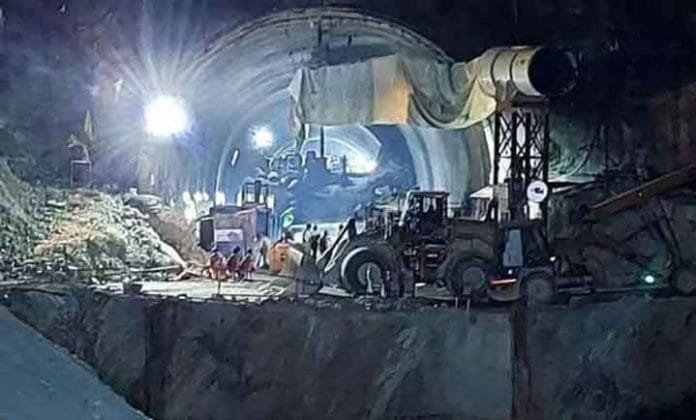India’s 8 km Tunnel from Leh to Pangong – India is set to undertake a monumental infrastructure project aimed at improving connectivity to its strategic China border. In a move that reflects the country’s commitment to strengthening its border infrastructure, the government has announced plans to construct an 8 km long tunnel from Leh to Pangong Lake. This tunnel, passing through the Kela Pass, will serve as a critical link, ensuring all-weather movement and providing smoother access to the Pangong Lake region—a strategically significant area near the Indo-China border.
The government’s decision comes in response to the need for enhanced transportation options to facilitate quicker and more reliable travel, not just for civilians but also for defense forces. The border infrastructure project is designed to overcome the challenges posed by the region’s difficult terrain and unpredictable weather conditions, ensuring year-round connectivity despite the challenges posed by the extreme altitude and harsh weather.
Strategic Importance of the Leh-Pangong Tunnel Project
The Leh-Pangong tunnel holds significant strategic value for both national security and economic development. Located at a staggering altitude of 18,600 feet above sea level, Kela Pass is the highest pass in India, which makes it treacherous for travelers. Currently, accessing Pangong Lake requires crossing this pass, a route that is not only risky due to weather conditions but also time-consuming.
The completion of the tunnel will drastically reduce the travel time from Leh to Pangong Lake. It will also enhance logistical support for defense operations along the border, ensuring that armed forces can move efficiently even in adverse conditions. The strategic importance of the region cannot be understated, as it lies close to the border with China. The tunnel will thus bolster national security by ensuring that Indian defense forces can deploy resources rapidly, especially during emergencies.
Significant Challenges and the Cost of Construction
The proposed tunnel will span approximately 8 km, a distance that poses its own set of engineering challenges. The project is projected to cost around Rs 6000 crore, making it one of the most ambitious infrastructure undertakings in the region. The construction of such a tunnel is not only a technical feat but also an expensive one, requiring advanced technology and meticulous planning to overcome the high-altitude terrain and harsh weather conditions.
The tunnel will pass through rock formations at high altitudes, which will require specialized excavation techniques and technologies. It will also need to be built with the capacity to handle severe weather fluctuations, ensuring that it remains operational even during the extreme winters when temperatures can plunge to minus 40 degrees Celsius. The engineering team will need to account for potential issues such as frost heave, snow accumulation, and frequent landslides in the region.
Boosting Tourism and Economic Activities in Ladakh
In addition to its defense and strategic importance, the Leh to Pangong Lake tunnel will have a significant economic impact. The region, which has long been a popular tourist destination, will benefit greatly from improved accessibility. With easier access to Pangong Lake and other nearby areas, the tunnel is expected to encourage both domestic and international tourism.
By boosting tourism, the project will also stimulate local economies. Businesses that rely on tourist traffic, such as hospitality providers, transport services, and local artisans, stand to gain. This, in turn, will help provide much-needed economic growth in Ladakh, a region that has faced developmental challenges due to its remoteness.
Furthermore, the availability of better infrastructure is expected to create new opportunities for business investment in Ladakh. This will foster regional growth and provide sustainable livelihoods to the local population.
Strengthening India’s Border Infrastructure
This tunnel is just one part of a broader initiative by the Indian government to strengthen border infrastructure in the northern and eastern regions of the country. In 2022, the Ladakh administration proposed the construction of four new tunnels at Khardung La, Fotu La, Namika La, and Kela Pass, all of which are part of an effort to enhance connectivity and mobility in the strategically crucial border areas.
These projects are designed not only to improve civilian access but also to facilitate the smooth and efficient movement of military forces, enabling them to respond quickly to any security threats. The government’s commitment to improving the defense infrastructure underscores the importance of the region in India’s national security strategy.
The Role of the Border Roads Organization (BRO) and National Highways and Infrastructure Development Corporation (NHIDCL)
The construction of the Leh-Pangong tunnel is a joint effort between the Border Roads Organization (BRO) and the National Highways and Infrastructure Development Corporation (NHIDCL), two key agencies under the Ministry of Road Transport and Highways. Discussions are ongoing regarding the allocation of responsibilities between these bodies, with both entities bringing their expertise in infrastructure development to the table.
The BRO, known for its expertise in building roads in challenging terrains, will likely play a pivotal role in ensuring the tunnel’s construction proceeds smoothly. Meanwhile, the NHIDCL, which focuses on developing national highways and infrastructure in difficult areas, will provide its support to ensure the tunnel’s construction adheres to national standards.
Environmental and Social Impact Considerations
While the tunnel will bring substantial benefits, there are also considerations to be made regarding its environmental and social impact. The construction of a tunnel at such a high altitude will inevitably have some effects on the local ecology. However, the government is committed to mitigating these effects through careful planning and sustainable construction practices. Efforts will be made to minimize disruption to the fragile ecosystem of the Himalayas while ensuring that the project delivers its strategic and economic benefits.
Socially, the tunnel is expected to enhance the lives of local communities by facilitating better access to healthcare, education, and other essential services. It will also improve the delivery of goods and services to remote areas, which will uplift living standards in Ladakh.
Conclusion: A Pivotal Step Toward National Security and Regional Development
The Leh to Pangong Lake tunnel is set to be a game-changer for both national security and regional development. By providing year-round access to one of India’s most strategically sensitive areas, the tunnel will bolster the country’s defense capabilities while simultaneously driving economic growth through enhanced tourism and business activities. This monumental infrastructure project is a testament to India’s commitment to developing its border regions, ensuring that the country remains secure and connected, no matter the weather conditions.
As discussions around the project continue and construction begins, the tunnel will undoubtedly play a pivotal role in shaping the future of India’s defense preparedness, economic prosperity, and connectivity.















